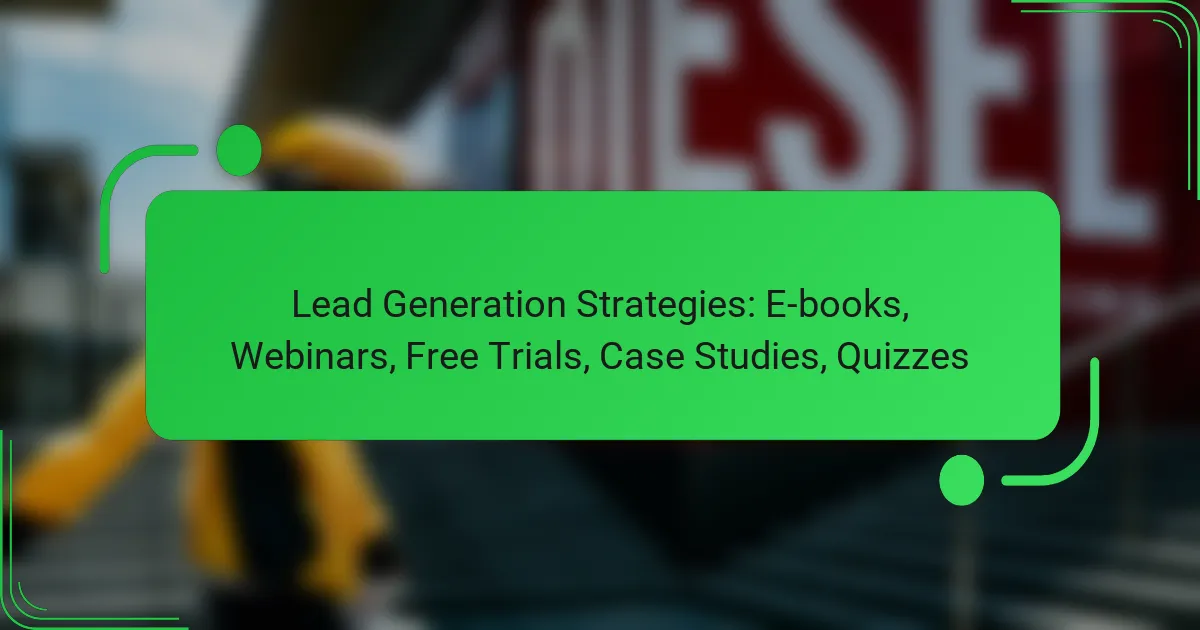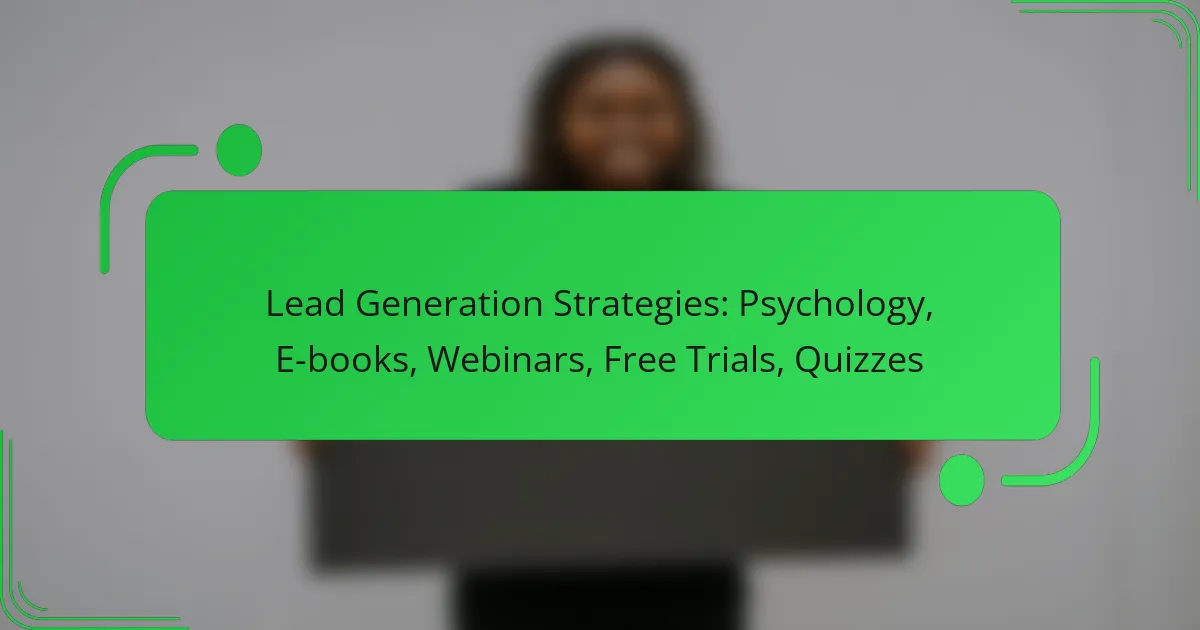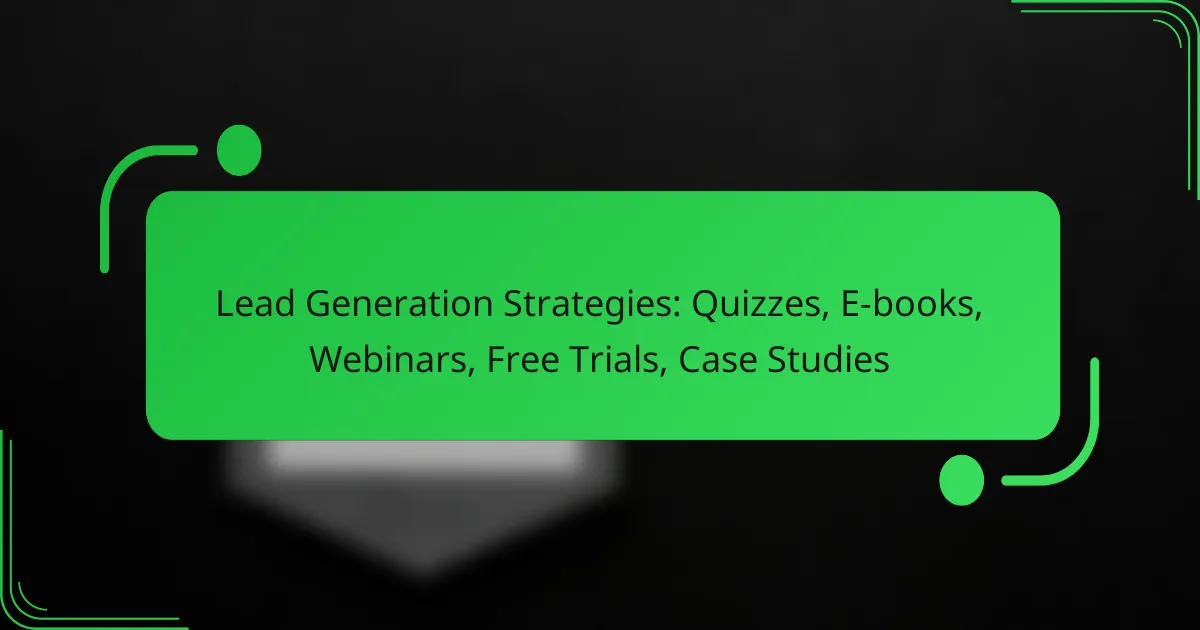Lead generation is crucial for businesses looking to expand their customer base, and several effective strategies can be employed to achieve this goal. Offering free trials, creating informative e-books, hosting engaging webinars, showcasing real-life case studies, and utilizing interactive quizzes are all powerful methods to capture interest and convert potential customers into leads. By implementing these strategies, businesses can build trust and demonstrate the value of their offerings, ultimately driving higher conversion rates.

What are effective lead generation strategies in Canada?
Effective lead generation strategies in Canada include offering free trials, creating engaging e-books, hosting informative webinars, showcasing case studies, and utilizing quizzes. These methods help capture interest, build trust, and convert potential customers into leads.
Free Trials as a lead magnet
Free trials allow potential customers to experience your product or service without any financial commitment. This strategy is particularly effective in the software industry, where users can explore features and benefits firsthand.
To implement free trials successfully, consider offering a limited-time access period, such as 14 to 30 days. Ensure that the onboarding process is smooth and provide ample support to guide users through the trial.
E-books for audience engagement
E-books serve as valuable resources that educate your audience while showcasing your expertise. By providing in-depth information on relevant topics, you can attract leads who are interested in your industry.
When creating an e-book, focus on a specific problem your audience faces and offer actionable solutions. Promote the e-book through your website and social media channels, and consider requiring an email address for download to capture leads.
Webinars to showcase expertise
Webinars are an effective way to engage with your audience in real-time while demonstrating your knowledge. They allow for interactive discussions and can address specific questions from participants.
To maximize attendance, promote your webinar in advance and choose a relevant topic that resonates with your target audience. Follow up with attendees afterward, providing additional resources and inviting them to take the next step in your sales funnel.
Case Studies for social proof
Case studies provide compelling evidence of your product or service’s effectiveness through real-life examples. They help build trust and credibility by showcasing how you have solved problems for existing customers.
When creating a case study, include specific metrics and outcomes to illustrate success. Share these case studies on your website and in marketing materials to attract potential leads who relate to similar challenges.
Quizzes to capture interest
Quizzes can engage users and capture leads by providing personalized results based on their responses. This interactive format encourages participation and can be a fun way for users to learn more about their needs.
To create an effective quiz, ensure it is relevant to your audience and offers valuable insights. Use the results to segment leads and tailor follow-up communications based on their interests and preferences.

How do free trials generate leads?
Free trials generate leads by allowing potential customers to experience a product or service without financial commitment. This hands-on approach can significantly increase interest and conversion rates, as users can evaluate the offering’s value before making a purchase decision.
Increased user engagement
Free trials often lead to heightened user engagement as potential customers interact with the product. This engagement can manifest in various ways, such as exploring features, seeking support, or sharing feedback. The more users engage, the more likely they are to recognize the product’s benefits and consider a purchase.
To maximize engagement, companies should ensure that the trial experience is seamless and user-friendly. Providing onboarding resources, such as tutorials or FAQs, can help users navigate the product effectively and encourage deeper exploration.
Lowered entry barriers
Offering free trials lowers entry barriers for potential customers by removing the financial risk associated with trying a new product. This approach appeals to users who may be hesitant to invest without first assessing the product’s effectiveness. By eliminating this barrier, businesses can attract a broader audience.
To further enhance this strategy, companies should clearly communicate the trial’s terms, such as duration and any limitations. Transparency helps build trust and encourages users to take the plunge, knowing they can opt-out if the product does not meet their needs.

What are the benefits of using e-books?
E-books offer numerous advantages for lead generation, including the ability to educate potential customers and establish a brand’s credibility. By providing valuable information in a digestible format, businesses can attract and engage their target audience effectively.
Establishing authority
Using e-books helps businesses establish authority in their industry by showcasing expertise and knowledge. When a company publishes a well-researched e-book, it positions itself as a thought leader, which can enhance trust among potential customers.
To maximize this benefit, focus on topics that address common pain points or emerging trends within your niche. For instance, an e-book on digital marketing strategies can attract businesses looking to improve their online presence.
Building email lists
E-books are an effective tool for building email lists, as they often require users to provide their email addresses in exchange for access. This strategy allows businesses to grow their contact lists while delivering valuable content to interested parties.
To optimize email list growth, ensure that the e-book is relevant and appealing to your target audience. Consider promoting it through social media, your website, or email campaigns to reach a wider audience. Offering additional resources or exclusive content can further incentivize sign-ups.

How can webinars enhance lead generation?
Webinars can significantly boost lead generation by providing an interactive platform for engaging potential customers. They allow businesses to showcase their expertise while collecting valuable contact information from attendees.
Real-time interaction with prospects
Webinars facilitate real-time interaction, enabling businesses to address questions and concerns from prospects immediately. This engagement fosters a sense of connection and trust, which can lead to higher conversion rates.
To maximize this interaction, consider incorporating live polls or Q&A sessions. These tools encourage participation and provide insights into the audience’s interests and pain points.
Demonstrating product value
Webinars are an effective way to demonstrate the value of a product or service in a practical context. By showcasing real-life applications and benefits, businesses can illustrate how their offerings solve specific problems for potential customers.
Utilize case studies or customer testimonials during the webinar to reinforce your message. Highlighting success stories can resonate with attendees and motivate them to take the next step in the buying process.

What role do case studies play in lead generation?
Case studies are essential tools in lead generation as they demonstrate real-world applications of a product or service, showcasing how it has effectively solved problems for clients. By providing concrete examples of success, they can significantly influence potential customers’ decisions.
Showcasing successful outcomes
Case studies highlight successful outcomes by detailing specific challenges faced by clients and how your product or service addressed those challenges. This narrative approach allows potential leads to visualize the benefits they could experience, making the information more relatable and compelling.
For instance, a software company might present a case study showing how its solution reduced a client’s operational costs by 30% over six months. Such quantifiable results can be persuasive in attracting new leads.
Building trust with potential clients
Trust is a critical factor in the decision-making process for potential clients, and case studies help establish that trust. By featuring testimonials and measurable results from satisfied customers, you create a sense of credibility and reliability around your offerings.
Including detailed client feedback and specific metrics in your case studies can enhance this trust. For example, a case study might include a quote from a client stating, “Thanks to this service, our sales increased by 50% in just one quarter,” which can resonate strongly with prospective customers.

How can quizzes be utilized for lead generation?
Quizzes can effectively generate leads by engaging users and collecting valuable information through their responses. By offering an interactive experience, businesses can attract potential customers while gathering insights into their preferences and needs.
Engaging users with interactive content
Quizzes captivate users by providing a fun and interactive way to engage with content. They can be designed around topics relevant to your audience, such as product knowledge or industry trends, making them more appealing. For example, a skincare brand might create a quiz to help users determine their skin type, encouraging participation and sharing.
To maximize engagement, ensure that quizzes are visually appealing and easy to navigate. Shorter quizzes, ideally under five minutes, tend to retain user interest better. Incorporating elements like instant feedback or personalized results can further enhance the user experience.
Segmenting leads based on responses
Quizzes allow businesses to segment leads effectively based on the answers provided. By analyzing responses, companies can identify specific interests, pain points, or demographics, enabling more targeted marketing efforts. For instance, a fitness brand could tailor follow-up emails based on whether a user is interested in weight loss or muscle gain.
To implement this strategy, create quizzes with questions that align with your marketing goals. Use a scoring system or categories to classify responses, which will help in crafting personalized follow-up content. This targeted approach increases the likelihood of converting leads into customers by addressing their unique needs.

What criteria should be considered when choosing a lead generation strategy?
When selecting a lead generation strategy, it’s essential to consider the target audience, available resources, and the overall goals of your marketing efforts. Each strategy has unique strengths and weaknesses that can significantly impact its effectiveness in attracting potential customers.
Target audience preferences
Understanding your target audience’s preferences is crucial for effective lead generation. Different demographics may respond better to specific strategies; for example, younger audiences might prefer interactive content like quizzes, while professionals may favor in-depth resources such as e-books or webinars.
Conducting surveys or analyzing past engagement metrics can provide insights into what types of content resonate most with your audience. Tailoring your approach based on these preferences can enhance engagement and conversion rates.
Resource availability
Resource availability plays a significant role in determining which lead generation strategy to implement. Consider factors such as budget, time, and personnel. For instance, webinars may require more time and technical resources compared to offering downloadable e-books.
Evaluate your team’s capabilities and the tools at your disposal. If resources are limited, starting with simpler strategies like case studies or quizzes can be effective. As your capacity grows, you can expand into more resource-intensive options.



